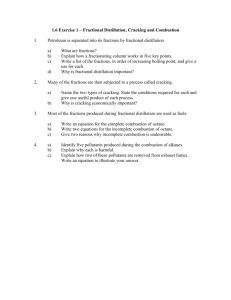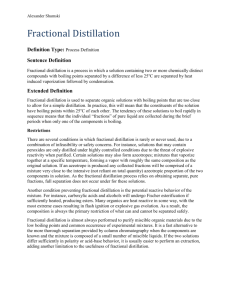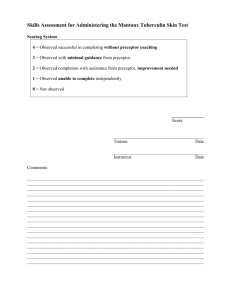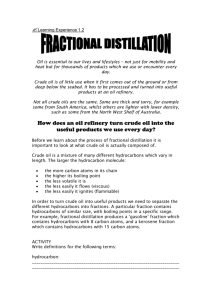Fractional Distillation
advertisement
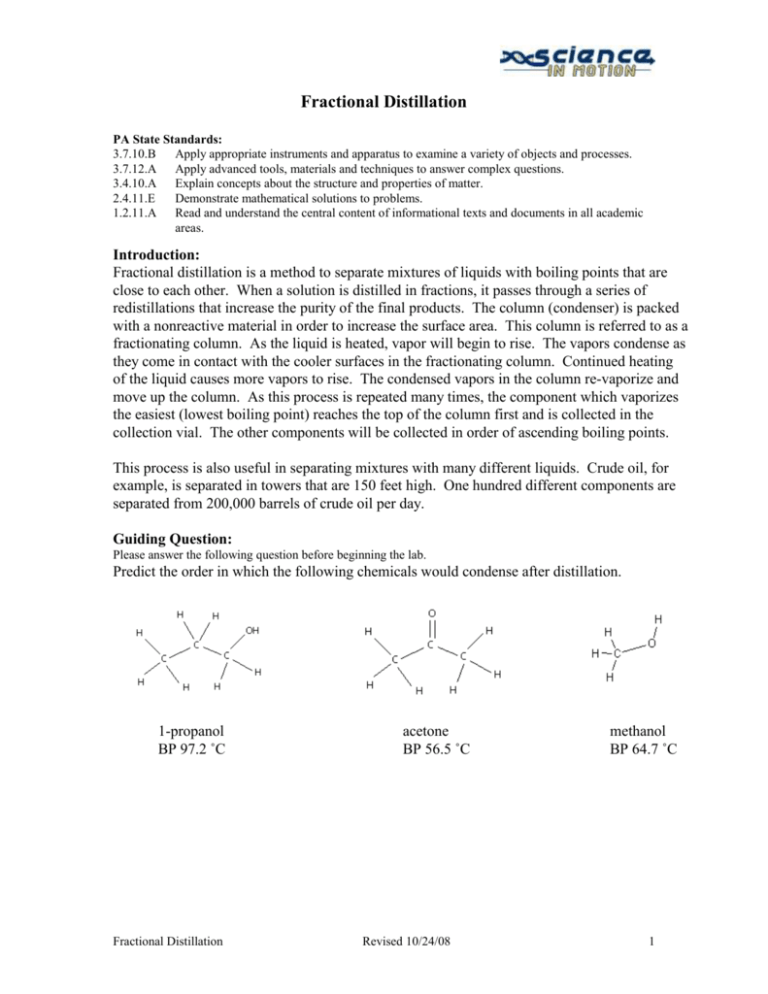
Fractional Distillation PA State Standards: 3.7.10.B Apply appropriate instruments and apparatus to examine a variety of objects and processes. 3.7.12.A Apply advanced tools, materials and techniques to answer complex questions. 3.4.10.A Explain concepts about the structure and properties of matter. 2.4.11.E Demonstrate mathematical solutions to problems. 1.2.11.A Read and understand the central content of informational texts and documents in all academic areas. Introduction: Fractional distillation is a method to separate mixtures of liquids with boiling points that are close to each other. When a solution is distilled in fractions, it passes through a series of redistillations that increase the purity of the final products. The column (condenser) is packed with a nonreactive material in order to increase the surface area. This column is referred to as a fractionating column. As the liquid is heated, vapor will begin to rise. The vapors condense as they come in contact with the cooler surfaces in the fractionating column. Continued heating of the liquid causes more vapors to rise. The condensed vapors in the column re-vaporize and move up the column. As this process is repeated many times, the component which vaporizes the easiest (lowest boiling point) reaches the top of the column first and is collected in the collection vial. The other components will be collected in order of ascending boiling points. This process is also useful in separating mixtures with many different liquids. Crude oil, for example, is separated in towers that are 150 feet high. One hundred different components are separated from 200,000 barrels of crude oil per day. Guiding Question: Please answer the following question before beginning the lab. Predict the order in which the following chemicals would condense after distillation. 1-propanol BP 97.2 ˚C Fractional Distillation acetone BP 56.5 ˚C Revised 10/24/08 methanol BP 64.7 ˚C 1 Science in Motion Juniata College Equipment / Materials 3 glass vials 100-mL beaker Boiling chips Crystallizing Dish Digital thermometer Hot plate Ice Microscale kit Mixture of organic liquids Sand Steel wool Opt. Equipment/Materials 1-propanol Acetone Gas Chromatograph Kimwips Laptop Methanol Printer Syringe Safety: Wear safety glasses at all times in the lab. Do NOT use open flames. Open flames may ignite the fumes of the distillation. Do not spray water into the sand bath - hot sand will spray and have the potential to burn someone, especially in the eyes. When using a hot plate with a sand bath, do not heat the hot plate on a high setting. Clamp both the beaker and condenser securely but not tight enough to break the glassware. Procedure: 1. If using the GC to analyze the fractions, run a sample of the mixture before you begin the distillation. 2. Pour about 3 - 4 mL of the unknown mixture into the short necked roundbottom flask. Add a boiling chip. 3. Set up your apparatus as Figure 1 indicates. As you set up, be sure to check that the rubber connectors are not torn. If needed, puncture a hole in a rubber septum to fit the digital thermometer. 4. Place ice and water in the beaker surrounding the collection vial to serve as an ice Fractional Distillation Revised 10/24/08 Figure 1. bath. 2 Science in Motion Juniata College 5. Heat slowly with a hot plate until the liquid gently boils. Note the condensation of the vapor as it rises in steps through the steel wool. (Remember to not set the hot plate on a high setting.) 6. The temperature will increase rapidly at first as the vapor condenses on the end of the thermometer. At this point, the temperature will remain fairly constant, around 57 °C. This is the boiling point of the first liquid. Liquid will start to drip into the vial. 7. The temperature will decrease slightly before beginning to increase further. As the temperature decreases, carefully remove the vial, label it "A," and place a new vial in the cold water. The second component should begin to condense and drip into the vial around 65 °C, as this is the boiling point of the second liquid. 8. As the temperature decreases, carefully remove the vial, label it "B", and place it in a new vial. The third component should begin to condense around 97 °C, as this is the boiling point of the third liquid. Collect some of the third fraction, but do NOT allow the flask to boil dry. Label this vial "C". 9. Carefully remove the thermometer, and let the apparatus cool completely. 10. Carefully disassemble the distillation apparatus, and place the pieces in the appropriate spaces in the microscale kit. Data Table: Fraction A B C Boiling point Identity Questions: 1. How would using a longer column affect the purity of the components collected? 2. How would using a longer column affect the time required to completely separate the mixture? 3. How would using more packing material in the column affect the purity of the components collected? 4. How would using more packing material in the column affect the time required to completely separate the mixture? Fractional Distillation Revised 10/24/08 3 Science in Motion Juniata College Optional Extension: Identification and Purity using Gas Chromatography 1. Turn on the laptop and log on. 2. Turn on the GC plug it into the laptop. 3. Start the Peak Sample software. A data acquisition system popup should appear with phrases like initializing, waking up, signing on, setting modes, and calibrating. 4. Click on edit menu, then select channels. Under Channel 1, pick Temperature. Click on the numbers to highlight them, then click Change. Change the numbers as follows: Start 150C Hold 10 minutes Ramp 0 degree / min Until the temperature is 150C 5. Be sure the time scale starts at zero and ends at 10 min. Use the arrows to adjust. 6. Clean the syringe by rinsing it 10 -- 15 times with one of the standards. With the plunger fully depressed, place the needle into the sample. Slowly draw up the plunger to obtain a sample in the syringe. Remove the syringe from the sample. Discharge this sample into the sink or onto a Kimwipe. Depress the plunger, and put the syringe needle back into the sample. Draw up a second sample and discharge it. Repeat. Do not push on the plunger when the needle is inside a sample. 7. Place the syringe needle back into the sample and withdraw over 1 microliter. Remove the needle from the sample bottle, then depress the plunger to the 1 microliter line. Wipe the needle with a Kimwipe. 8. Click on the Z or button on the run screen to zero the current. 9. Insert the needle carefully into the injection port of the GC until the entire needle is inside the instrument. 10. Inject the sample and start the data collection simultaneously by depressing the syringe plunger and pressing the space bar on the computer at the same time. 11. When the sample peak of a standard returns to baseline, the run may be stopped by pressing the end button on the computer. After pressing end, print the graph. Be sure to label the graph. 12. Repeat steps 4-9 for the other standards and the collected fractions. When running an unknown sample, be certain to let the data collect long enough to get all possible peaks. Fractional Distillation Revised 10/24/08 4 Science in Motion Juniata College Data and Calculations: Identify the chemicals in the fractions by comparing the retention times in the fractions to those of the standards. Use the area of the peaks to determine the precent compostion of each fraction. Create an organized method of presenting your data and results. Fractional Distillation Revised 10/24/08 5



